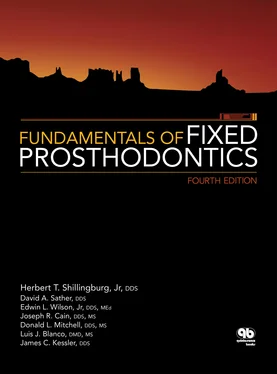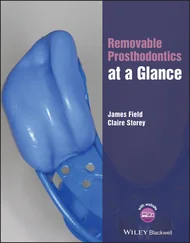7 Treatment Planning for the Replacement of Missing Teeth
The need to replace missing teeth is obvious to the patient when the edentulous space is in the anterior segment of the mouth, but it is equally important in the posterior region. It is tempting to think of the dental arch as a static entity, but that is certainly not the case. It is in a state of dynamic equilibrium, with the teeth supporting each other ( Fig 7-1). When a tooth is lost, the structural integrity of the dental arch is disrupted, and there is a subsequent realignment of teeth as a new state of equilibrium is achieved. Teeth adjacent to or opposing the edentulous space frequently move into it ( Fig 7-2). Adjacent teeth, especially those distal to the space, may drift bodily, although a tilting movement is a far more common occurrence.
If an opposing tooth intrudes severely into the edentulous space, it is not enough just to replace the missing tooth ( Fig 7-3). To restore the mouth to complete function, free of interferences, it is often necessary to restore the tooth opposing the edentulous space ( Fig 7-4). In severe cases, this may necessitate the devitalization of the supererupted opposing tooth to permit enough shortening to correct the plane of occlusion; in extreme cases, extraction of the opposing tooth may be required.
Selection of the Type of Prosthesis
Missing teeth may be replaced by one of three prosthesis types: a removable partial denture, a tooth-supported fixed partial denture, or an implant-supported fixed partial denture ( Table 7-1). Several factors must be weighed when choosing the type of prosthesis to be used in any given situation. Biomechanical, periodontal, esthetic, and financial factors, as well as the patient’s wishes, are some of the more important ones. It is not uncommon to combine two types in the same arch, such as a removable partial denture and a tooth-supported fixed partial denture. Combining teeth and implants in the support of the same fixed partial denture, however, is not recommended.
In treatment planning, there is one principle that should be kept in mind: treatment simplification. There are many times when certain treatments are technically possible but too complex. It is important to narrow the possibilities and present a recommendation that will serve the patient’s needs and still be reasonable to accomplish. At such times, the restorative dentist, or prosthodontist, is the one who should manage the sequencing and referral to other specialists. He or she will be finishing the treatment and should act as the quarterback. The restorative dentist must communicate and be open to suggestions but should not allow someone else to dictate the restorative phase of the treatment, which may result in carrying out a treatment plan that seems unfeasible. As the clinician who is providing the restoration, the restorative dentist is the one the patient will return to if it fails; therefore, he or she must be comfortable with the planned treatment.
The following are guidelines, not laws, and they are not absolute. However, when a preponderance of these items is used in the consideration of the planning for one arch or one mouth, a compelling reason exists for the selection of the type of prosthesis described.
Removable partial denture
A removable partial denture is generally indicated for edentulous spaces greater than two posterior teeth, anterior spaces greater than four incisors, or spaces that include a canine and two other contiguous teeth (ie, central incisor, lateral incisor, and canine; lateral incisor, canine, and first premolar; or the canine and both premolars).
An edentulous space with no distal abutment will usually require a removable partial denture. There are exceptions in which a cantilever fixed partial denture can be used, but this solution should be approached cautiously. See the section on cantilevers later in the chapter for a more detailed description of this type of restoration. Multiple edentulous spaces, each of which may be restorable with a fixed partial denture, nonetheless may call for the use of a removable partial denture because of the expense and technical complexity. Bilateral edentulous spaces with more than two teeth missing on one side also may call for the use of a removable prosthesis instead of two fixed prostheses.
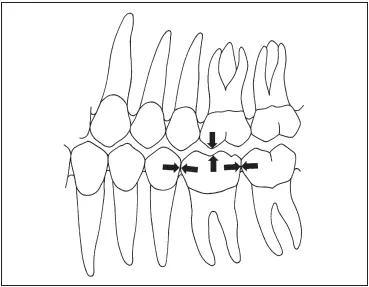
Fig 7-1Tooth position and alignment are maintained in part by the interaction between teeth ( arrows ).
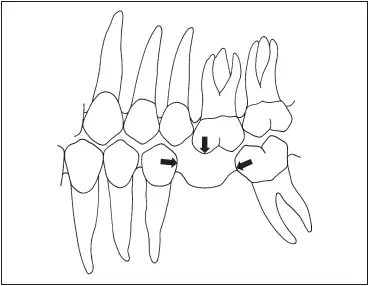
Fig 7-2When a tooth is removed or lost, adjacent teeth often migrate into the vacated space.
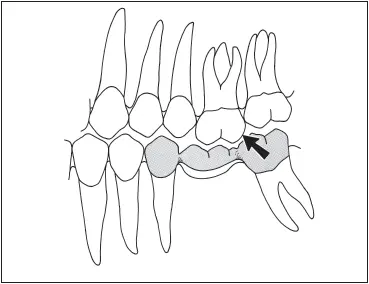
Fig 7-3If a fixed partial denture is fabricated without first reestablishing the occlusal plane, an occlusal interference may be created ( arrow ).
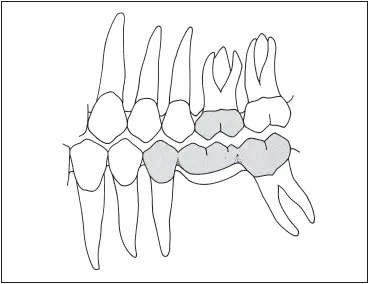
Fig 7-4Occlusion is properly restored by correction of the occlusal plane in conjunction with placement of a fixed partial denture.
The requirements of an abutment for a removable partial denture are not as stringent as those for a fixed partial denture abutment. Tipped teeth adjoining edentulous spaces and prospective abutments with divergent alignments may lend themselves more readily to use as removable rather than fixed partial denture abutments. Periodontally weakened primary abutments may serve better in retaining a well-designed removable partial denture than in bearing the load of a fixed partial denture. It is also possible to design the partial denture framework so that retentive clasps will be placed on teeth other than those adjacent to the edentulous space.
Short teeth or those with short clinical crowns usually are not good fixed partial denture abutments for anything other than a single pontic prosthesis. An insufficient number of abutments may also be a reason for selecting a removable rather than a fixed partial denture.
If there has been a severe loss of tissue in the edentulous ridge, a removable partial denture can more easily be used to restore the space both functionally and esthetically. For successful removable partial denture treatment, the patient should demonstrate acceptable oral hygiene and show signs of being a reliable recall candidate.
Table 7-1 Types of prostheses used for the replacement of missing teeth
Patients of advanced age who are on fixed incomes or have systemic health problems may require special treatment simplification efforts, either to cut down on the amount of appointment time required to restore the mouth or to make the treatment affordable. Cajoling patients of limited means into overinvesting their resources is not in their best interest.
A large tongue is a good reason to avoid a removable prosthesis if at all possible, as is a lack of muscular coordination. An unfavorable attitude toward a removable partial denture also makes it a poor choice.
Conventional tooth-supported fixed partial denture
When a missing tooth is to be replaced, a fixed partial denture is preferred by the majority of patients. The usual configuration for a fixed partial denture uses an abutment tooth on each end of the edentulous space to support the prosthesis. If the abutment teeth are periodontally sound, the edentulous span is short and straight, and the retainers are well designed and executed, the fixed partial denture can be expected to provide a long life of function for the patient. Several factors influence the decisions of whether to fabricate a fixed partial denture, what teeth to use as abutments, and what retainer designs to use (see Table 7-1).
Читать дальше
